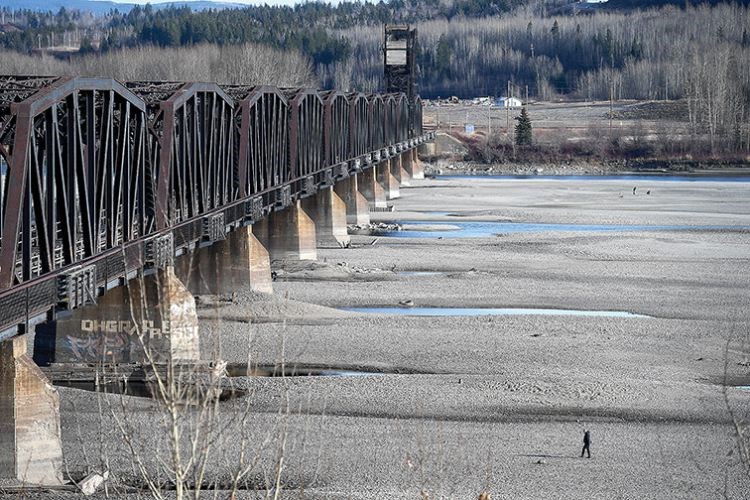The unseasonably low water levels along the Fraser and Nechako rivers - and all the events that have led up to it - may be a typical sight in the years to come, according to a provincial government hydrologist.
"In a lot of ways, when we look at climate change projections, the types of things that we expect to happen more frequently are very much demonstrated this year," River Forecast Centre head Dave Campbell said Tuesday.
Unprecedented heat followed by unseasonably dry weather has led to the current situation. Exceptionally warm temperatures in April and May caused the snowpack to melt more rapidly than usual and over the last three months the amount of rainfall has been "less than half or even a third" of what the region typically gets.
"And probably the biggest driver has been that persistent dry weather," Campbell added.
As of Tuesday, the Fraser's level at South Fort George stood at 3.5 metres, compared to 5.3 metres on the same day last year, according to Environment Canada measurements.
"We've seen this year extremes at either end," Campbell said. "The early melt, which was quite extreme and then the dry, low-flow season which is also extreme in terms of the context of the long-term history of this river."
Although the lowest on the 70 years of records the RFC has kept, Campbell said the depth is still higher than what is usually seen during the winter as the headwaters get snowed in and produce less runoff.
Looking ahead, Campbell said a bit of rain over the next 10 days is in the forecast.
"So there might be a bit of a bump up but at this point we're not expecting any major correction in terms of the flows," he said.
Because its wells are about 30 metres deep, the city's water supply has not been affected.
"However, residents should at all times be conserving water, and are reminded that the city's water use restrictions are in effect all year round," city spokesperson Mike Kellett said. "The cost of the infrastructure, maintenance, pumping, and treating of the water is the primary reason for the city's efforts towards water conservation."
On Thursday, the Nechako Watershed Roundtable core committee issued a "statement of concern" saying it has "grave concerns for the health of the Nechako Watershed following a decade of unprecedented wildfire, and other changes, in our watershed."
"The combination of the Mountain Pine Beetle epidemic, salvage logging, and major wildfires, has created a series of threats within the watershed, with severe implications for runoff and flood risk, erosion, water quality, and habitat, and related community impacts and concerns."
It called on the provincial government to conduct a review of the timber supply in accordance with a recommendation in a report authored by former Liberal MLA and cabinet member George Abbott and Maureen Chapman, hereditary chief of the Skawahlook First Nation in Agassiz following the 2017 fires and floods.
"This recommendation would lead to better landscape level planning (watershed level planning) and ensure that we are looking at and conserving all values of the land base," the committee said in the statement.
In an interview, Wayne Salewski, who chairs the NWR's working group for the Nechako white sturgeon, pinned the blame for the low water levels on the scramble to harvest beetle-killed pine.
"The water is no longer metered out from underneath the canopy," he said. "Everything is just simply exposed and dried out. It's superheated, an obvious end result when you lay the land barren.
"If you were to look out there, it's just amazing. There isn't a mature forest left within an hour and a half of my house and I live in downtown Vanderhoof."



